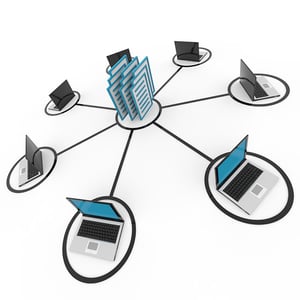1 min read
Six Must-Have Tips for Successful Paperless Manufacturing Selection and Implementation
Let the experts offer you insider tips on successfully navigating your next shop floor software project. By Nick Stonebraker and David Oeters with...
4 min read
David Oeters : October 29, 2014 at 5:49 AM
 System integration.
System integration.
For many manufacturers, the term has taken on mythical, magical, properties. Like some IT or software unicorn, many companies are questing for the holy grail of total “SYSTEM INTEGRATION.” They call it the “digital enterprise,” “enterprise integration,” or “operation integration.” Companies feed into the myth, believing they cannot achieve operational Nirvana without system integration. Current IT trends and tools lend support to these beliefs, especially big data and advanced analytics – both require integrated systems.
There are benefits to system integration for savvy manufacturers. It’s worth the investment, but many companies fail to fully realize the benefits in their single-minded focus on complete system integration. They may even be hurting production. The goal shouldn’t be a monolithic digital enterprise, but improved productivity and better business processes.
We want to take a brief look at system integration, focusing on the benefits and dangers rather than the technology (which can change quickly as new products and techniques are released), and offer tips on how you can design a more successful integration project.
System integration is a computer technique where individual software components are combined into an integrated whole. With interconnected systems, electronic data is shared and exchanged across the network, ensuring accurate information is available anywhere and at any time. Integration improves communication and coordination. By linking computer systems or software applications together, either physically or functionally, the entire computer network acts as a coordinated whole, eliminating information “silos” that occur when data is input in different locations.
There are several methods of system integration. Most utilize a variety of techniques, not just new software or hardware. Cultural adaptation and coordination, as well as an evaluation of business processes, are also required for a successful integration.
 The Benefits of system integration
The Benefits of system integrationThe primary benefit of integrated systems is improved functionality. Data within the organization will be fully harmonized, creating a more capable system, improving performance and enhancing existing systems. Reports will access more data, improving accuracy and decision-making while delivering better operational management.
Manufacturing pioneered the early study and use of system integration as companies sought improved operations through the use of Computer Integrated Manufacturing (CIM). In CIM, companies used computers to integrate manufacturing activities. By integrating computer systems, such as product development, process planning, production, and delivery and after sales, companies could deliver accurate information where and when it was needed, and in the format that was required.
Companies that smartly invested in CIM were rewarded. The US National Research Council asserts production can be improved through CIM by as much as 40 to 70 percent. Design costs can be reduced by 15 to 30 percent, and overall lead time can be reduced by 20 to 60 percent.
Simply pushing computer systems together, or imposing a new workflow process or computer application, is not enough to achieve beneficial system integration. Many times, the drive (or quest) for system integration begins in the front office, not the shop floor, which can lead to a number of problems for production. A system that benefits one department may not benefit or even work for another, hindering productivity, reducing benefit, and building resistance to the overall integration plan.
The fact is, the business processes and computer systems that work for finance, IT, or product design aren’t an optimal solution for production. An ERP is a transaction-based system, and the data, output and processes are different than a behavior- or process-based MES or paperless manufacturing system. A transaction-based system catalogs data, while a process-based system manages workflow with information. Trying to impose a transaction-based system on shop floor workflow is inefficient. Any advantage gained from the system integration is lost as more resources are required to complete work.
In an effort to create a common data format or a shared operational system for the integration, many companies will sacrifice operational efficiency. Manufacturers will lose the operational functionality they need. A transaction-based system will never offer the tools necessary to optimally manage redline edits or deliver process enforcement, even if it works great for HR or design.
Consider the cultural side of the equation. Can you imagine imposing engineering workflow or finance workflow on an assembly or production line? It sounds silly, but many companies do that when the purchase a “suite” of pre-integrated software systems. It delivers front office benefits by sacrificing operational efficiency.
Consider these tips as you evaluate the opportunities for system integration:
Set specific goals for the integration, and ensure those goals are met with a clear ROI. Many times, companies will continue to add functionality as their costs and project complexity grows exponentially. Add in the costs a piece of functionality may have to one area, and for some projects an ROI will never be achieved. Manage your initial expectations to focus on the initial key project drivers.
Look at not only a technical solution, but a cultural one as well. Start the process by breaking down the cultural boundaries in your company before rolling out a technical solution. This will require buy-in and consensus. Make clear not only the goals, but the expectations. Give each area a voice in the final solution, and ensure their needs are met.
Look at delivering the project in phases, rather than a single, massive installation. Any enterprise-wide system integration is more than just software installation, it requires a cultural shift. Tackling an enterprise project is not just technically difficult, but culturally difficult as well. A phased implementation will eliminate many of these problems.
Look for added value in the project, and ensure it is real value, and not just functionality. For example, linking design and production on a single system is one tactic, but many times system integration can be as simple as sharing a single database with revision control and an approval process, and doesn’t require an entirely new software package. The value of the project is achieved without the additional and unnecessary complexity.
Beware of vendors promising an “integrated” solution. Many companies are working to build “digital enterprise” software. Their tactic is to “purchase” solutions to be integrated into their own system. The result of these purchases is often problematic. The integration the vendor makes by smashing the system together may not match your current processes or needs, and will add complexity to the installation at your site. The benefit the vendor gains by marketing an “integrated” solution does not translate to your shop floor or enterprise.
System integration doesn’t require a single “master” system to manage operations. Look at sharing data across relevant systems using an application-independent data format. This project can easily be done in phases. For example, send orders from your ERP to your MES, automatically generating orders for production. Once a product ships, send the product data to the PLM to create a master record. Strategically link your systems to maximize value and increase functionality, rather than making wholesale changes to your operation or workflow that lead to enterprise disruption and the never-ending project “roll-out” that is outdated by the time it finally launches.
Just like a magic unicorn, more often than not a single “enterprise” system sounds good, but the implementation is problematic. Forcing change and new processes to ensure a single system isn’t integration. It leads to unnecessary complexity, project delays, and problems. When planning a project, consider the needs of each area, and how the system will benefit them. Conduct the project in phases, with clear goals and expectations. Want to learn more, or see how you can begin a phased implementation of a system integration project? Give us a call or leave a message.
1 min read
Let the experts offer you insider tips on successfully navigating your next shop floor software project. By Nick Stonebraker and David Oeters with...
1 min read
Smart businesses have discovered data is a valuable asset, but struggle to deliver shop floor visibility, letting manufacturing data slip away. By...

Spend enough time in the manufacturing software industry, and you’ll find software experts, manufacturing experts, and plenty of salespeople, but an...